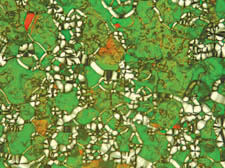|
|
 |
| |

Microscope DNA molecules Image by Michi Nakata, University of Colorado |
‘I’ll bet you a case of fine port I’m right about the future of humanity’
Two Camden scientists with ‘fortified’
opinions on the human genome project have entered into an intriguing wager –
but there’s far more than a case of Portugal’s finest at stake, writes
Simon Wroe
SCIENCE has always been a kissing cousin of the truth rather than truth itself. Sir Isaac Newton observed at the end of his life that he felt “like a boy playing on the seashore… while the great ocean of truth lay all undiscovered before me”.
That ocean has been charted extensively in the three centuries since Newton’s death; but much remains unknown. How close we are to the answers has long been a bone of contention for scientists. Stephen Hawking made a bet about black holes with a fellow cosmologist, Christopher Wren clashed with Newton over the movements of the planets, and physicist Richard Feynman lost $1,000 dollars – in an argument over mechanical motors.
In July this year, two Camden scientists joined the list. Leading biologists Professor Lewis Wolpert and Dr Rupert Sheldrake agreed to a historic wager on one of science’s big questions: the predictive value of the genome.
If the ramifications to health, medicine and society as a whole are not incentive enough, a case of fine Quinta do Vesuvio 2005 port is also at stake. The port is being held under lock and key in the cellars of The Wine Society until the wager is decided 20 years hence, on May 1 2029.
According to the terms of the bet, Wolpert, emeritus professor of biology at University College London, believes that: “By May 1, 2029, given the genome of a fertilised egg of an animal or plant, we will be able to predict in at least one case all the details of the organism that develops from it, including any abnormalities.”
In other words, our grasp of genetics will be so advanced we will need only to study a sample of an embryo to know everything about what that organism will become.
Dr Sheldrake, on the other hand, thinks Wolpert’s faith in the power of the genome
(or genetic code) is “misplaced”. He bets science will not have covered sufficient ground to make those predictions. If the winner is not obvious, the Royal Society will adjudicate.
Both men agree no one can predict the way an embryo will develop at present – but that is pretty much all they agree on. In every other respect, the two scientists are fundamentally opposed.
Wolpert, of Belsize Park, is a dour 79-year-old academic, highly respected in biology circles for his work on “positional information”, which explains how cells “know” where they are within the field of a developing organ.
Sheldrake, 67, is an excitable former plant cell biologist turned parapsychologist who lives in Hampstead. He has written books on “Dogs that Know When Their Owners are Coming Home” and “The Sense of Being Stared At” based on his theory of “morphic resonance” – that there is a field within and around every animate or inanimate object which organises its structure and dictates behaviour.
Many of his scientific peers dismiss morphic resonance as bunk, a “pseudoscience” which cannot be proved or disproved. Even Wolpert, a friend of 40 years, makes no bones that Sheldrake’s beliefs are “all nonsense”.
Strangely, this is the first wager between the two, made after an impassioned debate on the nature of life at the Cambridge Science Festival earlier this year.
Wolpert groans when it is mentioned: “I shouldn’t really have got into it. In a moment of weakness I said yes. I don’t even like port – Rupert chose it. But I won’t be alive in 20 years time so I don’t care.
“I think it would be very helpful if I was right. One could then design stem cells in order to make particular organs and also one would be able to make good predictions as to how embryos would develop, including human embryos.”
Hedging his bet, Wolpert concedes the human genome is “even more complicated”, adding: “If I was right it would be with some quite simple animal, like a worm. And twenty years is optimistic, it will probably be more likely 40.”
Sheldrake disagrees. How organisms develop is far more complicated than geneticists believe, he says, and owes much to morphogenetic fields which nobody understands. He points to the Chimpanzee Genome Project, the data of which, though complete, failed to show how chimps differed from humans. It is a case of “the more we know, the less we know”.
“The Human Genome Project has itself set back the hopes it engendered,” he claims, arguing there is no such thing as a simple classification of genes: humans have at least 50 genes associated with being tall or short, for instance. He adds: “Wolpert is not alone in believing in the predictive value of the genome. Governments, venture capitalists and medical charities have bet and are still betting billions of dollars on it. More than a case of fine port is at stake.” |

|
 |
| |
|
 |
|

